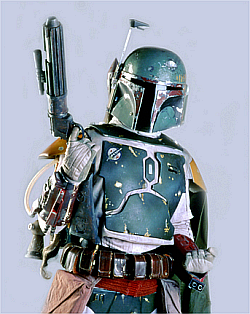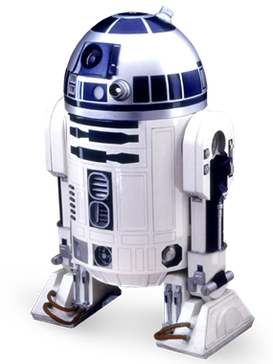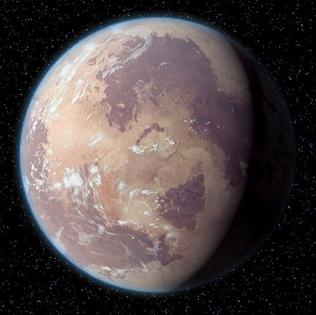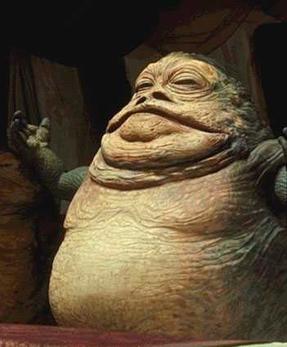
Return of the Jedi is a 1983 American epic space opera film that is the sequel to Star Wars (1977) and The Empire Strikes Back (1980). It is the third installment in the original Star Wars trilogy and the sixth chronological film in the "Skywalker Saga". It is directed by Richard Marquand based on a screenplay by Lawrence Kasdan and George Lucas from a story by Lucas, who was also the executive producer. The film follows the ongoing struggle between the malevolent Galactic Empire and the freedom fighters of the Rebel Alliance. As the Rebels attempt to destroy the Empire's second Death Star, Luke Skywalker hopes to bring his father, Darth Vader, back from the dark side of the Force. The film stars Mark Hamill, Harrison Ford, Carrie Fisher, Billy Dee Williams, Anthony Daniels, David Prowse, Kenny Baker, Peter Mayhew and Frank Oz.

Boba Fett is a fictional character in the Star Wars franchise. First appearing in the Star Wars Holiday Special (1978), where he was voiced by Don Francks, he is an armored bounty hunter featured in both the original and prequel film trilogies. In the original trilogy, the character is a supporting antagonist and was mainly portrayed by Jeremy Bulloch and voiced by Jason Wingreen. Notable for his taciturn demeanor and for never removing his helmet, Fett appears in both The Empire Strikes Back (1980), employed by the Galactic Empire, and Return of the Jedi (1983), serving the crime lord Jabba the Hutt. While seemingly killed in Return of the Jedi after falling into a sarlacc, he has since appeared in Star Wars media set after the film, confirming his survival within the new canon, portrayed by Temuera Morrison. Daniel Logan plays a preteen Boba in the prequel film Attack of the Clones (2002), which reveals the character's origins as the genetic clone and adoptive son of Jango Fett, also a famous bounty hunter. Morrison appeared first in Star Wars media playing Jango. The animated series The Bad Batch further reveals Boba to have been born Alpha, and to have a biological twin sister, Omega. The series also reveals that he has another sister named Emerie Karr.

R2-D2 or Artoo-Detoo is a fictional robot character in the Star Wars franchise created by George Lucas. He has appeared in ten of the eleven theatrical Star Wars films to date, including every movie in the original trilogy, prequel trilogy, and sequel trilogy. At various points throughout the course of the films, R2, an astromech droid, is a friend to C-3PO, Padmé Amidala, Anakin Skywalker, Leia Organa, Luke Skywalker, and Obi-Wan Kenobi. R2-D2 and his companion C-3PO are the only characters to appear in every theatrical Star Wars film, with the exception of Solo: A Star Wars Story (2018).

C-3PO or See-Threepio is a humanoid robot character in the Star Wars franchise who appears in every movie of the original trilogy, the prequel trilogy and the sequel trilogy. Built by Anakin Skywalker, C-3PO was designed as a protocol droid intended to assist in etiquette, customs, and translation, boasting that he is "fluent in over six million forms of communication". Along with his astromech droid counterpart and friend R2-D2, C-3PO provides comic relief within the narrative structure of the films, and serves as a foil. Anthony Daniels has portrayed the character in eleven of the twelve theatrical Star Wars films released to date, with the exception of Solo: A Star Wars Story, where the character does not appear.

Tatooine is a fictional desert planet that appears in the Star Wars franchise. It is a beige-colored, desolate world orbiting a pair of binary stars, and inhabited by human settlers and a variety of other life forms. The planet was first seen in the original 1977 film Star Wars, and has to date featured in a total of seven Star Wars theatrical films, three live-action television series, and four animated series.

A radio dramatization of the original Star Wars film trilogy was produced in 1981, 1983, and 1996. The first two radio series, based on Star Wars and The Empire Strikes Back, were produced and broadcast by National Public Radio (NPR) as part of NPR Playhouse. A dramatization of Return of the Jedi was produced by most of the same team and it was also broadcast on NPR.

The sandcrawler is a fictional transport vehicle in the Star Wars universe that is found on the desert planet Tatooine. The vehicle, as it appears in its major appearances in Star Wars Episode IV: A New Hope, is 37 meters long and 18 meters tall. Only a 27-meter length of its lower hull was constructed as a set for the film. Other appearances were simulated with matte paintings and a remote-controlled model.

Banthas are fictional creatures in the Star Wars franchise. They are large, quadrupedal mammals with long, thick fur, and are first seen in the film Star Wars (1977), where they are used as beasts of burden by Tusken Raiders on the planet Tatooine. They have since been featured in several other Star Wars works, including the Special Edition version of Return of the Jedi (1983), the prequel films The Phantom Menace (1999) and Attack of the Clones (2002), and the television shows Star Wars: The Clone Wars, The Mandalorian, and The Book of Boba Fett, as well as video games and books.

Bib Fortuna is a fictional character in the Star Wars franchise. The Twi'lek majordomo and chief aide of the crime lord Jabba the Hutt, Bib is Jabba's closest associate, succeeding him as daimyo after his death before ultimately being killed himself by Boba Fett. Fortuna first appeared in Return of the Jedi (1983), the final entry in the original Star Wars trilogy. He also appeared briefly in the prequel trilogy film The Phantom Menace (1999) and in the second season of Disney+ series The Mandalorian (2020) and The Bad Batch (2021). The character has also appeared in other Star Wars media, including novels, comic books, video games, and radio dramas.

Star Wars: Droids: The Adventures of R2-D2 and C-3PO is a 1985 animated television series spin off from the original Star Wars trilogy. It focuses on the exploits of droids R2-D2 and C-3PO between the events of Revenge of the Sith and A New Hope. The series was produced by Nelvana on behalf of Lucasfilm and broadcast on ABC with its sister series Ewoks.

Many of the films in the Star Wars franchise have been re-released, both theatrically and on home media formats. Franchise creator George Lucas often altered the films for the re-releases. These alterations range from minor refinements to major changes. The original trilogy was altered the most, although revisions were also made to the prequels. According to Lucas, some changes brought the films closer to his original vision, while others were attempts to create continuity with later films.

The Hutts are an alien species in the Star Wars franchise. They are rotund, voracious and grotesque-looking slug-like creatures with a predisposition to being leaders in organized crime. The most famous Hutt and the first to be depicted was Jabba the Hutt in the films Return of the Jedi, the Special Edition release of A New Hope, and The Phantom Menace. Jabba and numerous other Hutts appear in various works of the Star Wars expanded universe, which greatly elaborates on their history, culture and role in galactic society.

The Max Rebo Band is a fictional alien pop music band in the Star Wars franchise, first appearing in the 1983 film Return of the Jedi as in-house performers for crime lord Jabba the Hutt. The lineup originally seen in the film consists of the blue-skinned Ortolan organist Max Rebo, a plump Kitonak woodwind player named Droopy McCool, and the Pa'lowick lead singer Sy Snootles, while additional members were inserted into the later-edited Special Edition of the film. A great deal of further information about the band and the personal histories of its members is found in various literature of the now-noncanonical Star Wars Expanded Universe.

The Ewoks are a fictional species of small, furry, mammaloid, bipeds in the Star Wars universe. They inhabit the forest moon of Endor and live in arboreal huts and other simple dwellings, being seen as primitive in comparison with other sentient species. Ewoks debuted in the 1983 feature film Return of the Jedi and have since appeared in two made-for-television films, The Ewok Adventure (1984) and Ewoks: The Battle for Endor (1985), as well as a 2D animated series, several books and games, and briefly in the 2019 feature film Star Wars: The Rise of Skywalker.

Jabba Desilijic Tiure, more commonly known as Jabba the Hutt, is a fictional character and major antagonist in the Star Wars franchise. Created by George Lucas, Jabba is voiced by Larry Ward with several puppeteers inside a one-ton puppet portraying him in Return of the Jedi. He was originally supposed to first appear in Star Wars (1977) as a stop motion character with Declan Mulholland as his stand-in. Jabba was later added into the film as a CGI character when it was re-released in Special Edition in 1997. He also appears in the prequel movie The Phantom Menace. The character is a large slug-like creature based on annelid worms and originally designed as an apelike figure.

Mandalorians are a fictional group of people associated with the planet Mandalore in the Star Wars universe and franchise created by Joe Johnston and George Lucas. Their appearance is often distinguished by gear such as battle helmets, armor, and jetpacks.



















